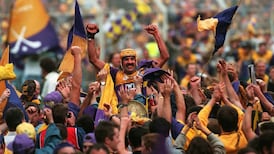The new hierarchical structure for the hurling league will come into focus this weekend. There are concerns that it will copper-fasten the status of the leading counties and create a self-perpetuating oligarchy through the disproportionate benefits of being included in that group.
For the winners – the top seven counties when the regulation matches are concluded – there will be an intensely competitive top flight from next year.
This has obvious on-field benefits for those Division 1A teams, sharpening their game against other elite teams. The slight irony is that such intense competition – two teams will be relegated every year – is the reason why the format was changed in the first place.
In 2020 the blending in of ‘development’ counties to make up a 12-team top division equally allocated into two groups was partly in response to the desire of leading teams to be able to experiment and build panel depth without any fear of relegation.
READ MORE
To that end the lower-ranked counties acted as a buffer zone against relegation for leading teams, who would be required to do the minimum to maintain status.
That structure led to a lot of predictable outcomes and persuaded the CCCC (Central Competitions Control Committee) to alter the system to create uncertainty of outcomes and bolster the threat of relegation, in other words to increase the number of competitive matches.
The appeal to top counties is obvious. Although they will all have to manage their player development within an ultra-competitive environment, the advantages are very real. Even the move to seven-team divisions guarantees three home fixtures.
Retired Dublin CEO John Costello used to joke that a county looking to turn a profit would be best off contesting the league all the way to the final and then getting knocked out of the championship in the first round, as used to be possible, or at least at the earliest opportunity.
That is because the league pays whereas championship costs.
League protocols ordain that a home team takes 20 per cent of the gate and the rest is shared between the counties. In championship, the home team gets 15 per cent although all staging costs are borne by the organising body – provincial council or CCCC.
The annual accounts of Cork GAA indicate the value of hurling league matches. For the past two years, the county has staged the best attended match of the divisional stages. A year ago, the visit of All-Ireland champions Limerick attracted 19,516 and last month, 16,274 rolled up for Kilkenny’s appearance in SuperValu Páirc Uí Chaoimh, an attendance unlikely to be surpassed on either of the two remaining weekends.
Last year Cork made €279,037 from league dividends, split between hurling (€178,191) and football (€100,846). The hurling came from the matches against Limerick, Westmeath and Wexford whereas the football was unusually high because of a run of home matches in Division 2 against Meath, Dublin and Derry.
For comparison, the previous year, hurling brought in €222,388 after a campaign, including the Limerick match, that saw Cork reach the final but football came in at only €41,207, from fixtures with Clare, Galway and Down.
The value of playing box-office opposition registers at the turnstiles.
Limerick may have brought in nearly 20,000 last year but Westmeath attracted 7,347. Get regraded to Division 1B, which is still a possibility for Cork, and takings will be more Westmeath and less Limerick.
Galway chair Paul Bellew takes up that issue.
“Honestly, yes. That’s one of the reasons why we supported change – that and the improved competitiveness. The league share of the gate is much more impactful than for championship. Therefore, the bigger the games we have and the more games we have, the better it is for us and that’s a huge part of funding a county.
“Financially there’s no doubt about it. To be in Division 1A in hurling and Division 1 in football makes a significant difference.”
He hopes to be able to install floodlights next year to facilitate Saturday evening matches. There is a growing consensus that such scheduling suits everyone, players and spectators – even allowing for the inhibiting effect on away supporters.
There is another perspective. Wexford chair Micheál Martin explains that his county voted against the new format although he emphasises that they are confident of being in the new Division 1A.
“We were strongly against it,” he says. “Having discussed it at a county board meeting and spoken to all stakeholders, we decided it wasn’t in the best interests of the league. I also think in two years’ time when this is reviewed, it will not have been deemed a success.
“I think the groups of seven will create a yo-yo effect. If the league share allocation remains the same there’s going to be a significant drop in funding for those counties. If we’re talking about the promotion of hurling, we can’t afford those counties, whoever they turn out to be, to take that sort of hit without reviewing the distribution mechanisms.”
He makes the point that two of their matches this year, against Offaly and Clare, were played in terrible weather on Saturday nights, which meant they were also televised and that had an impact on attendance.
Overall, although there is no dividend for appearing in a televised match, there is no doubt that such profile benefits sponsors and promotes the game within a county.
This weekend, matches between Waterford and Wexford and Galway and Dublin will be significant in determining who is likely to make the top seven places – three from 1A and 1B plus the fourth-placed county with the better record.
Haves and have-nots.
- Listen to our Inside Politics Podcast for the latest analysis and chat
- Sign up for push alerts and have the best news, analysis and comment delivered directly to your phone
- Find The Irish Times on WhatsApp and stay up to date
















